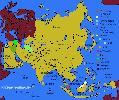|
|
|
|
|
|
|
|
|
|
|
|
|
|
| | |
|
|
|
|
| | |
| Name | latin |
Ambivia undata |
| english |
Asian twig-mantis |
| |
|
| | IGM-Number | 84 |
| |
|
| Systematics
Systematics
|
|
All data for the systematics is taken from Reinhard Ehrmann's book "Mantodea - Gottesanbeterinnen der Welt" (Mantodea - Praying mantids of the world).
More about this book can be found in the section literature at this page.
|

|

| Super-Order |
Dictyoptera |
| Order |
Mantodea |
| Family |
Mantidae |
| Subfamily |
Vatinae |
| Tribe |
Danuriini |
| |
|
| | First Description | Author |
FABRICIUS |
| Year |
1793 |
| |
|
| Size
Quotation of Size
|
|
The given size is measured from the head to the end of the abdomen, without the wings.
|

|

| Male |
4cm - 5cm |
| Female |
5cm - 6cm |
| |
|
| Lifespan
Quotation of the Lifespan
|
|
The lifespan is given in month and has the following definition:
overall-age ("time between hatching and imago" + "lifespan after the last molting")
Example: 9 (2 + 7) month lifespan
overall-age = 9 month
time between hatching and imago = 2 month
lifespan after the last molting = 7 month
|

|

| Male |
6 (4 + 2) months / ~ 7 moltings |
| Female |
10 ( 5 + 5) month / ~ 8 moltings |
| |
|
| Sexing
Sexing
|
|
Morphologically differences between male and female.
|

|

| Male |
L5 and above: essentually thinner than females, 8 abdominal plates
adult: volant, thinner than females, wings longer than the abdomen, 8 abdominal plates, long antennas |
| Female |
L5: more compact than males, 6 abdominal plates
adult: nonvolant, more compact than males, 6 abdominal plates, short antennas |
| |
|
| | | | Spreading
Spreading
|
|
For a better overview, only whole countries are listed for the quotation of spreading, even if a species can only be found in a small part of that country.
All data for the spreading is taken from Reinhard Ehrmann's book "Mantodea - Gottesanbeterinnen der Welt" (Mantodea - Praying mantids of the world).
More about this book can be found in the section literature at this page.
At the menu "Spreading" for each country only the genus but the species is printed (Exception: on this site described species).
|

|

| Thailand, Malaysia, North-Vietnam, Myanmar |
| |
| |
| |
|
| | |
|
|
 |
| Asia |
|
| | Habitat | bushes and shrubbes |
| |
|
| | Aggressiveness | middle to high |
| |
|
| | Colorvariants | none |
| |
|
| | Hint | In case of danger, they spread their arms far away from their body and remain in their canouflage-behavior motionless. |
| |
|
|
| |
|
|
|
|
|
|
|
|
|

